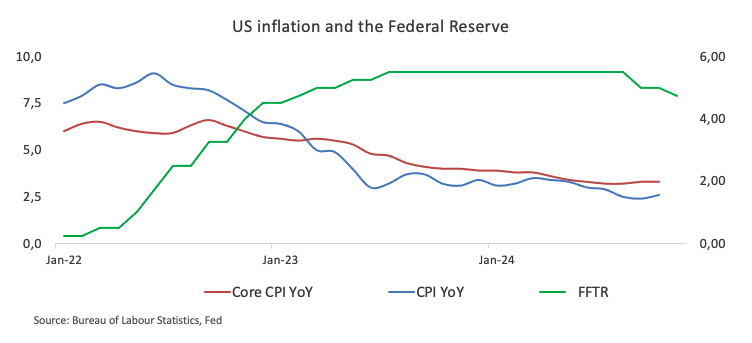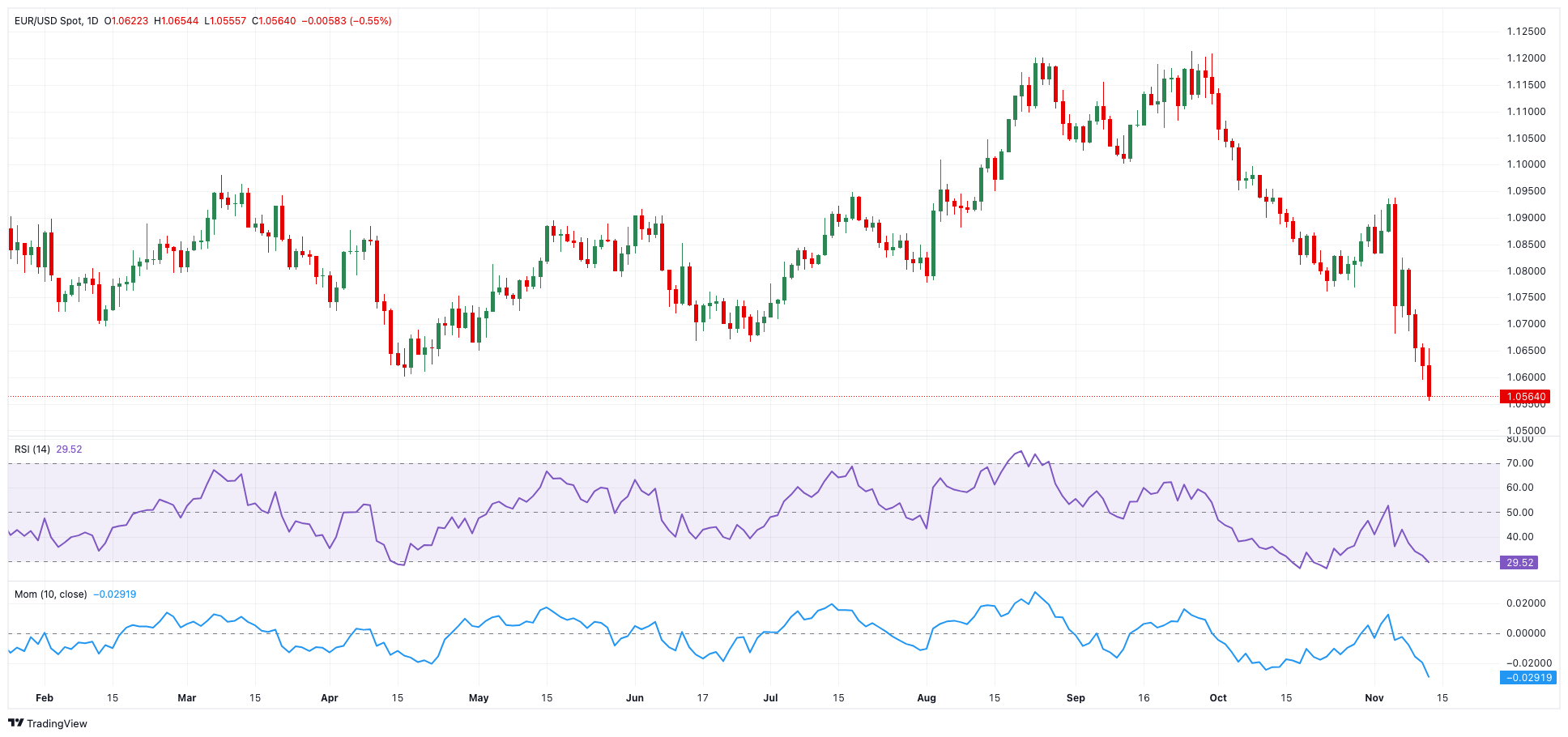- EUR/USD hit new yearly lows in the 1.0550 region on Wednesday.
- The rally in the US Dollar remained unabated and approaches the 2024 highs.
- US inflation data showed the headline CPI ticked higher in October.
EUR/USD remained well on the defensive on Wednesday, retreating for the fourth day in a row and hitting new 2024 lows near 1.0550, always on the back of the incessant upside impetus in the Greenback, pushing the Dollar Index (DXY) near YTD peaks around 106.50.
As usual, the move higher in the US Dollar (USD) was fueled by investor optimism around potential economic policies under the incoming Trump administration, the so-dubbed "Trump trade”.
The pair’s retracement, in the meantime, came in tandem with gains in US yields in the belly and the long end of the curve, while Germany’s 10-year bund yields added to previous gains and surpassed the 2.40% level, or three-day highs.
On the policy side, the Federal Reserve (Fed) cut the Fed Funds Target Rate (FFTR) by 25 basis points last week, aligning with expectations and bringing it down to a 4.75%-5.00%.
The Fed noted that inflation is gradually nearing its 2% target, while the labour market shows signs of softening despite still-low unemployment. Notably, the Fed’s language was slightly adjusted, now stating inflation has "made progress," a subtle shift from its prior wording.
Fed Chair Jerome Powell remained non-committal on the December policy decision at his press conference, highlighting ongoing economic uncertainties. He noted recent positive data had eased some risks but firmly denied any intention to resign if asked by President-elect Trump.
Still around the Fed, Minneapolis Fed President Neel Kashkari expressed optimism about inflation trends, arguing he does not believe inflation is stuck above the 2% target. He pointed to easing pressures from falling goods inflation, a slowdown in wage growth, and a gradual decline in housing-related inflation as lower leases slowly work their way into the data. It is worth noting that his remarks, however, came before the release of US CPI data.
Meanwhile, Dallas Fed President Lorie Logan urged caution regarding future interest rate cuts, emphasising the need to avoid reigniting inflation. She highlighted potential risks, including a possible surge in business investment following the election and continued robust consumer spending. Logan also commented on the labour market, noting that while it appears to be cooling, the current 4.1% unemployment rate suggests there hasn’t been any significant deterioration yet.
Across the Atlantic, the European Central Bank (ECB) cut its deposit rate to 3.25% on October 17 but opted for a wait-and-see stance before deciding on any additional measures, focusing on upcoming economic data.
Looking ahead, the new Trump administration’s potential trade policies, including tariffs on European and Chinese imports, could drive inflation higher in the US. Meanwhile, if the Fed leans towards a more cautious or hawkish approach, scaling back on rate hikes, it might provide additional support for the US Dollar.
Back to the US docket, inflation gauged by the headline CPI rose by 2.6% in the year to October and 3.3% YoY when measured by the core CPI, which strips food and energy costs.
Speculators’ sentiment has also shifted slightly: net short positions in the euro have decreased, hitting a three-week low at around 21.6K contracts, while hedge funds and commercial traders trimmed their net longs slightly, reflecting caution as open interest edged lower.
EUR/USD daily chart
EUR/USD short-term technical outlook
Extra losses may push the EUR/USD down to its 2024 low of 1.0555 (November 13), ahead of the November 2023 low of 1.0516 (November 1) and the 2023 bottom of 1.0448 (October 3).
On the upside, the 200-day SMA of 1.0866 provides immediate resistance, followed by the November peak of 1.0936 (November 6) and the transitory 55-day SMA of 1.0957.
Meanwhile, more declines are predicted as long as the EUR/USD remains below the 200-day SMA.
The four-hour chart shows that the downward trend has picked up pace. Against this, the initial support level is 1.0555, prior to 1.0516. On the opposite side, the immediate up-barrier is 1.0726, followed by 1.0824. The relative strength index (RSI) fell to about 25.
Information on these pages contains forward-looking statements that involve risks and uncertainties. Markets and instruments profiled on this page are for informational purposes only and should not in any way come across as a recommendation to buy or sell in these assets. You should do your own thorough research before making any investment decisions. FXStreet does not in any way guarantee that this information is free from mistakes, errors, or material misstatements. It also does not guarantee that this information is of a timely nature. Investing in Open Markets involves a great deal of risk, including the loss of all or a portion of your investment, as well as emotional distress. All risks, losses and costs associated with investing, including total loss of principal, are your responsibility. The views and opinions expressed in this article are those of the authors and do not necessarily reflect the official policy or position of FXStreet nor its advertisers. The author will not be held responsible for information that is found at the end of links posted on this page.
If not otherwise explicitly mentioned in the body of the article, at the time of writing, the author has no position in any stock mentioned in this article and no business relationship with any company mentioned. The author has not received compensation for writing this article, other than from FXStreet.
FXStreet and the author do not provide personalized recommendations. The author makes no representations as to the accuracy, completeness, or suitability of this information. FXStreet and the author will not be liable for any errors, omissions or any losses, injuries or damages arising from this information and its display or use. Errors and omissions excepted.
The author and FXStreet are not registered investment advisors and nothing in this article is intended to be investment advice.
Recommended Content
Editors’ Picks

USD/JPY remains below 158.00 after Japanese data
Soft US Dollar demand helps the Japanese Yen to trim part of its recent losses, with USD/JPY changing hands around 157.70. Higher than anticipated Tokyo inflation passed unnoticed.

AUD/USD weakens to near 0.6200 amid thin trading
The AUD/USD pair remains on the defensive around 0.6215 during the early Asian session on Friday. The incoming Donald Trump administration is expected to boost growth and lift inflation, supporting the US Dollar (USD). The markets are likely to be quiet ahead of next week’s New Year holiday.

Gold hovers around $2,630 in thin trading
The US Dollar returns from the Christmas holidays with a soft tone, although market action seems contained. The positive tone of Asian shares weighs on the Greenback.

Floki DAO floats liquidity provisioning for a Floki ETP in Europe
Floki DAO — the organization that manages the memecoin Floki — has proposed allocating a portion of its treasury to an asset manager in a bid to launch an exchange-traded product (ETP) in Europe, allowing institutional investors to gain exposure to the memecoin.

2025 outlook: What is next for developed economies and currencies?
As the door closes in 2024, and while the year feels like it has passed in the blink of an eye, a lot has happened. If I had to summarise it all in four words, it would be: ‘a year of surprises’.

Best Forex Brokers with Low Spreads
VERIFIED Low spreads are crucial for reducing trading costs. Explore top Forex brokers offering competitive spreads and high leverage. Compare options for EUR/USD, GBP/USD, USD/JPY, and Gold.

